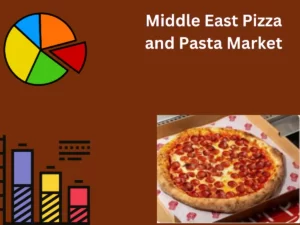
- Published 2024
- No of Pages: 200
- 20% Customization available
Middle East Pizza and Pasta Market Research Report, Analysis and Forecast
Middle East Pizza and Pasta Market Synopsis
The pizza and pasta markets have seen significant growth in the Middle East in recent years. This trend can be attributed to several factors, including changing consumer preferences, the globalization of cuisine, and the growth of the tourism industry in the region.

With the rise of global cuisine, many consumers in the Middle East have become more interested in Italian food, particularly pizza and pasta. These dishes are often viewed as convenient, affordable, and flavorful, making them appealing to a wide range of consumers. Additionally, many Italian restaurants have opened in the region, offering consumers a variety of options and driving growth in the pizza and pasta markets.
Another factor contributing to the growth of the pizza and pasta markets is the increase in tourism in the Middle East. As more tourists visit the region, they bring with them a desire for familiar foods, including Italian cuisine. This has led to the expansion of Italian restaurants and the availability of pizza and pasta dishes in hotels, airports, and other tourist destinations.
According to a survey conducted by YouGov, pizza is the most popular dish among Middle Easterners, with over 70% of respondents saying they eat it at least once a week.
Pasta is also a popular dish in the region, with over 60% of respondents saying they eat it at least once a week.
The most popular type of pizza in the Middle East is cheese pizza, followed by pepperoni and vegetable pizzas.
Furthermore, the rise of delivery apps and services has made it easier for consumers in the Middle East to order pizza and pasta from the comfort of their homes or offices. This convenience factor has contributed to the growth of the pizza and pasta markets, particularly among busy urban consumers who prioritize convenience over cooking meals from scratch.
Overall, the pizza and pasta markets in the Middle East are expected to continue growing in the coming years, driven by changing consumer preferences, the globalization of cuisine, and the growth of the tourism industry in the region.
Middle East Pizza and Pasta Market: Overview
There are many different types of cuisine available in the pizza and pasta industry, including Italian, American, Mexican, Mediterranean, and others. Pizzas and pasta made in the Italian style are especially well-liked because these foods have a long culinary history in Italy. Additionally popular are American-style pizzas and pasta, with numerous fast-food companies giving their takes on these meals. Mexican-inspired pizzas and pastas are a more recent development on the market, and toppings like jalapenos and cilantro give the foods a distinctive flavour. Due to the use of wholesome, fresh ingredients like feta cheese, tomatoes, and olives, Mediterranean-style pizza and pasta are also becoming more and more popular.
There are numerous methods to order and eat food at the Pizza & Pasta market. Traditional dining-in involves consumers sitting down and taking pleasure in their meals at a restaurant. Another well-liked choice is takeout, where consumers may place an order and pick up their food to consume at home or while on the road. Internet ordering has grown in popularity recently, allowing clients to place orders from the convenience of their homes or offices and have their food delivered right to their door. There are also drive-thrus where customers can place orders and pick up their meals without getting out of their cars, as well as frozen pizzas and pasta varieties that can be purchased at grocery shops for preparation at home. These different segments cater to a variety of customer preferences and lifestyles, making the Pizza & Pasta market versatile and adaptable. `
Saudi Arabia Pizza and Pasta Market Synopsis
The Pizza and Pasta market in Saudi Arabia is growing due to the increasing demand for convenience foods. With the rise of fast-food chains, more people are looking for quick and easy meals that can be prepared quickly. Additionally, the increasing number of expatriates in Saudi Arabia has also contributed to the growth of this market as they bring with them their tastes and preferences for pizza and pasta. Furthermore, the availability of a wide variety of ingredients has made it easier for people to experiment with different recipes and create unique dishes.
UAE Pizza and Pasta Market Synopsis
The Pizza and Pasta market in the UAE is also growing due to the increasing number of tourists visiting the country. With its vibrant culture, diverse cuisine, and modern infrastructure, tourists are drawn to the UAE for its unique dining experiences. Additionally, many restaurants have started offering pizza and pasta dishes that cater to both local tastes as well as those from other countries. This has helped increase demand for these dishes in the region, leading to overall growth in this market.
Middle East Pizza and Pasta Market: Segmentation
The middle east has pizza and pasta market has been segmented into By Cuisine and Distribution Channels.
Based on the Cuisine, the middle east has a pizza and pasta market in Italian, American, Mexican, Mediterranean and Others. In 2021, the Italian pizza segment held a significant share. This is because Italians have a long-standing tradition of making delicious pizzas, and they are known for their high-quality ingredients. As a result, their pizzas have become very popular, and the segment continues to hold a large share of the global pizza market. Moreover, Italian pizzerias have been enthusiastically embraced by consumers in other countries as well, as they look to experience classic Italian flavours. For instance, pizza restaurants in the United States often offer “Neapolitan-style” pizzas, which are based on classic Italian recipes.
Based on Distribution Channels, the market is classified as Dine-in, Takeaway, Online Ordering, and others. In 2021, the segment is expected to account for a significant share of dine-in sales. There has been a shift in consumer sentiment in the past year as people have become more comfortable with the idea of dining in restaurants. As safety protocols become more established and restaurant capacity restrictions ease, more people are likely to return for dine-in experiences. This trend is likely to continue and accelerate in the coming year, due to the added convenience of dining in. In addition, there is the increased availability of services and options that cater to customers’ changing needs. For instance, many restaurants are now offering contactless menus, digital payment options, and even virtual waitlists and reservations to help customers feel more comfortable and secure when dining in.
Recent Developments
In 2021, the Middle East pizza and pasta space saw a number of significant developments.
- In January 2021, Pizza Hut Middle East launched its first-ever vegan pizza in the region. The new vegan pizza is made with a plant-based cheese alternative and is topped with mushrooms, onions, bell peppers, and tomatoes. The launch of the vegan pizza was part of Pizza Hut’s commitment to providing more plant-based options for its customers.
- In February 2021, Papa John’s Middle East announced a partnership with delivery service Talabat to expand its reach in the region. The partnership will allow customers to order Papa John’s pizzas and other menu items through the Talabat app or website.
- In 2021, Domino’s Pizza Middle East announced a merger with Just Eat Takeaway.com, an online food delivery platform. The merger will allow Domino’s to expand its presence in the Middle East and offer customers more convenience when ordering their favourite pizzas and pasta.
- In August 2021, Little Caesars Middle East opened its first restaurant in Dubai. The restaurant offers a variety of pizzas and pasta as well as salads and desserts. Customers can also order online or through the Little Caesars app for delivery or pickup.
In 2022, there were several acquisitions in the Middle East pizza and pasta company space.
- Saudi Arabia’s Almarai made a significant acquisition in the pizza market by purchasing Dubai-based pizza chain 800 Pizza. This move allowed Almarai to expand its presence in the region and gain access to 800 Pizza’s extensive network of stores. The acquisition was seen as a strategic move for Almarai, which aimed to strengthen its position in the market and offer a wider range of products to its customers. Overall, this acquisition has led to increased competition in the pizza market, resulting in better products and services being offered to customers in the region.
- In 2022, Talabat, a food delivery company based in Qatar, made a notable acquisition by purchasing a Kuwait-based pizza chain Pizza Inn. This strategic move allowed Talabat to strengthen its position in the market and expand its presence in Kuwait, while also gaining access to Pizza Inn’s widespread network of stores. The acquisition is expected to contribute significantly to Talabat’s growth and success in the region, as it enhances its ability to offer customers a diverse range of food options and improves its overall service quality.
The Middle East Pizza and Pasta Market are segmented as follows:
By Cuisine Type
- Italian
- American
- Mexican
- Mediterranean
- Others
By Distribution Channel
- Dine-In
- Takeaway
- Online Ordering
- Others
By Region
- The Middle East
- Saudi Arabia
- UAE
- Qatar
- Kuwait
- Oman
- Rest of the Middle East
“Every Organization is different and so are their requirements”- Datavagyanik
Companies We Work With






Do You Want To Boost Your Business?
drop us a line and keep in touch

